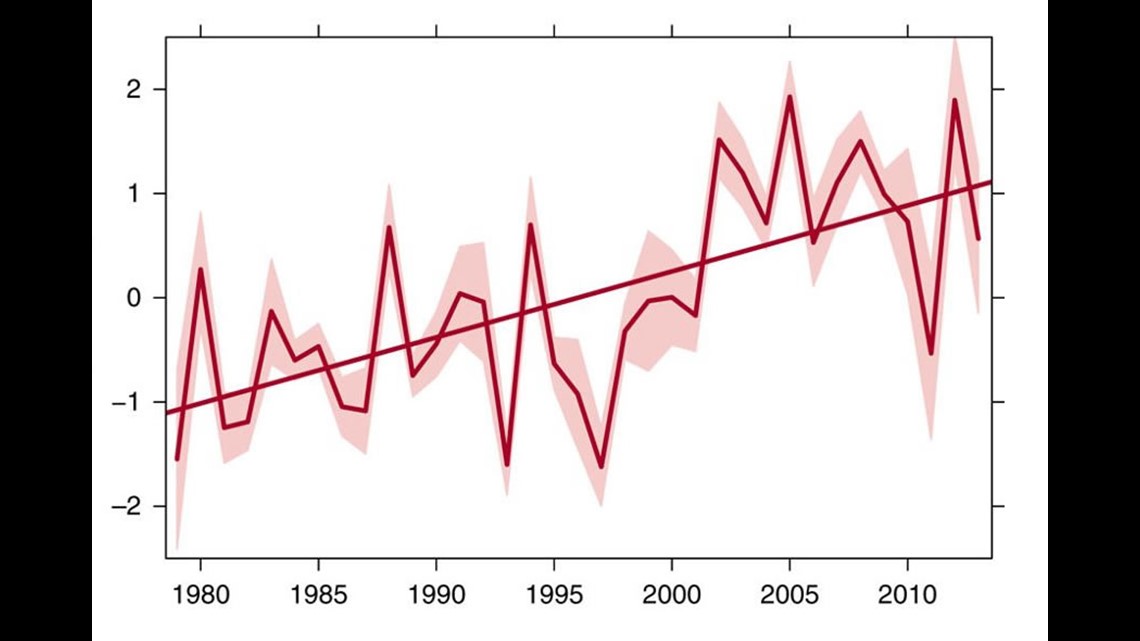The unhealthy air quality returned for a while Thursday afternoon.
Many people are still talking about it and how the Inland Northwest basically lost the entire month of August due to the smoke. Some are even asking why this seems like the new normal.
The truth is, we have always had fires in Eastern and Central Washington, as well as North Idaho. The smoke is definitely worse than in years, even decades, past.
The answer you may have heard already is "climate change." But that's not what we are talking about because what is really going on here is much more than that.
Officials at the Department of Natural Resources said what we are seeing is really a perfect storm of conditions on the ground, combined with fire policy, that allows for more fire and more smoke.
It all starts with fire seasons that keep getting longer. A chart from the U.S. Forest Service shows how fire seasons are steadily getting extended, dating back to 1980. It gets warmer earlier and stays warm longer.


The warming trend allows for all the fuels on the ground, and in the forest, to continue drying out. By August of each year, we have millions of acres of land that have become prime fire fuel. Each year that goes on, more trees die, and the fire fuel adds up.
If you think a wet winter helps, it does in the short term, but all the melting snow and rain in the spring makes all grass and small plants grow like crazy. But then, when summer heats up, all that grass dries out, and becomes more fuel, ultimately helping fire spread.
What is actually changing, is not fire itself, but "fire intensity" because what is burning now, is what has been mismanaged for decades. When a fire sparks today, there is a lot more fuel on the ground than there was last year, and the year before, all the way back for decades.
According to the National Interagency Fire Center. If you go back to 1983, there has been a very dependable increase in acres burned across the country. It is important to understand that does not mean more fires. It means the fires are getting bigger every single year.
If you are thinking, ‘What about the big burn more than 100 years ago?' Yes, the Great Fire in 1910 was way bigger than any of this. It was more than a thousand small fires that combined to burn 3 million acres across the entire mountain west. What we are talking about is fire during the age of modern firefighting.
Over the years, we have gotten very good at putting fires out. Which is good, but it is also bad because all that extra fuel, doesn't burn. It just keeps piling up. Instead of a healthy fire that comes through and thins things out, while leaving the big healthy trees, we get mega fires that destroy everything. Those are too big for anyone to stop. These are fires like the Tripod Fire, Carlton Complex, Okanogan Complex, Carpenter Road, and Chelan Complex. Not to mention what happened in Montana in 2017 and the last several years in California, Oregon and Canada. According to the BC Wildfire Service in British Columbia, they will occasionally let fires burn, if they can, just to try and stop that vicious cycle. This too, adds to our smoke problem.


Satellite images from NASA shows the Canadian wildfire smoke, from earlier in August, visible from one million miles away. They are having many of the same problems we are.
It takes money to fight fires like this. But as the firefight gets more expensive, all the money for things like insect control, tree thinning, and prescribed burning often has to be re-directed just to put the fires out. The year 2017 was the most expensive year yet for the Forest Service. More than $2 billion was spent just on fire suppression. The cost of putting fires out has gone from 15 percent of the budget to 55 percent and that number continues to grow. In Washington this year, DNR got $23 million in the budget for fire suppression. They are already spent $30 million, and by the end of this fire season, it is projected they will need $66 million.
It is not just wildfires that are making us breath in all this smoke every summer in the Inland Northwest. We have always seen fire here, we just have not seen fires like this.

